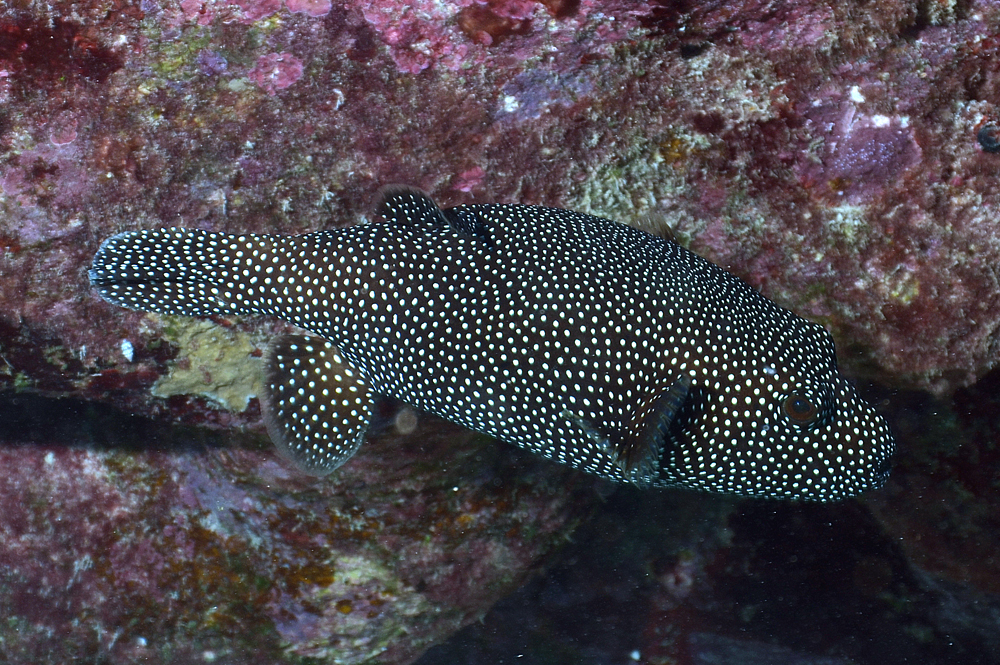Whitespotted Pufferfish, Arothron meleagris (Lacépède 1798)

A Whitespotted Pufferfish, Arothron meleagris, at Guam. Source: David Burdick / http://guamreeflife.com. License: All rights reserved
Whitespotted Pufferfish, Arothron meleagris (Lacépède 1798)
More Info
|
Distribution |
Scott Reef, north Western Australia, and off Cairns to Moreton Bay, Queensland, and possibly further south to the Solitary Islands, New South Wales; also Christmas Island in the eastern Indian Ocean, and the Lord Howe Province in the Tasman Sea. Elsewhere, the species is widespread in the Indo-Pacific: East Africa eastward through Indonesia to the tropical eastern Pacific. Occurs in coral-rich areas of clear lagoon and seaward reefs, inhabiting sandy and rubble areas on outer reef slopes, reef flats and lagoons, and also coastal bays and estuaries. Juveniles occur in estuaries, usually in weedy and seagrass areas. |
|
Features |
Dorsal fin 10–13; Anal fin 11–13; Pectoral fin 18–21. Nasal organ with 2 bifid tentacles; a single lateral line on side of body; head and body covered with small spinules except around mouth, caudal peduncle, and variable area of back, spinules best developed on ventral surface. |
|
Colour |
|
|
Feeding |
Feeds mostly on corals - feeding on the tips of branching corals; also feeds on sponges, molluscs, bryozoans, tunicates, forams, algae, and detritus. |
|
Remarks |
The species has black and yellow colour morphs. The less common yellow morph may be misidentified as Arothron nigropunctatus. |
|
Etymology |
The specific name is from the Greek meleagris (= guineafowl) in reference to the numerous white spots that resemble the colour pattern of a guineafowl. |
|
Species Citation |
Tetrodon meleagris Anonymous, in Lacepède 1798, Allgemeine Literatur-Zeitung 1798 (pt. 3) (no. 288): 684. Type locality: Mers de l'Asie. |
|
Author |
Bray, D.J. 2022 |
|
Resources |
Whitespotted Pufferfish, Arothron meleagris (Lacépède 1798)
References
Allen, G.R. & Erdmann, M.V. 2012. Reef fishes of the East Indies. Perth : Tropical Reef Research 3 vols, 1260 pp.
Allen, G.R., Hoese, D.F., Paxton, J.R., Randall, J.E., Russell, B.C., Starck, W.A., Talbot, F.H. & Whitley, G.P. 1976. Annotated checklist of the fishes of Lord Howe Island. Records of the Australian Museum 30(15): 365-454 figs 1-2
Allen, G.R. & Russell, B.C. 1986. Part VII Fishes. 79-103 in Berry, P.F. (ed.). Faunal Surveys of the Rowley Shoals, Scott Reef and Seringapatam Reef, northwestern Australia. Records of the Western Australian Museum, Supplement 25: 1-106.
Allen, G.R. & Steene, R.C. 1988. Fishes of Christmas Island Indian Ocean. Christmas Island : Christmas Island Natural History Association 197 pp.
Allen, G.R., Steene, R.C. & Orchard, M. 2007. Fishes of Christmas Island. Christmas Island : Christmas Island Natural History Association 2 edn, 284 pp.
Anonymous 1798. Paris b. Plassan: Histoire naturelle des poissons par le Cit. La Cepède, etc. Allgemeine Literatur-Zeitung, Berlin 3(288): 681-685. (ex Commerson in Lacepède)
Cole, A.J., Pratchett, M.S. & Jones, G.P. 2008. Diversity and functional importance of coral-feeding fishes on tropical coral reefs. Fish and Fisheries 9: 286-307.
Francis, M. 1993. Checklist of the coastal fishes of Lord Howe, Norfolk, and Kermadec Islands, southwest Pacific Ocean. Pacific Science 47(2): 136-170 figs 1-2
Francis, M.P. 2019. Checklist of the coastal fishes of Lord Howe, Norfolk and Kermadec Islands, southwest Pacific Ocean Version: 2019.1 https://doi.org/10.6084/m9.figshare.c.4428305
Guzman, H.M. & Robertson, R.D. 1989. Population and feeding responses of the corallivorous pufferfish Arothron meleagris to coral mortality in the eastern Pacific. Marine Ecology Progress Series 55: 121-131.
Johnson, J.W. 2010. Fishes of the Moreton Bay Marine Park and adjacent continental shelf waters, Queensland, Australia. pp. 299-353 in Davie, P.J.F. & Phillips, J.A. Proceedings of the Thirteenth International Marine Biological Workshop, The Marine Fauna and Flora of Moreton Bay. Memoirs of the Queensland Museum 54(3)
Kuiter, R.H. 1996. Guide to Sea Fishes of Australia. A comprehensive reference for divers and fishermen. Sydney, NSW, Australia : New Holland Publishers xvii, 434 pp.
Matsuura, K. 1994. Arothron caeruleopunctatus, a new puffer from the Indo-western Pacific. Japanese Journal of Ichthyology 41(1): 29-33.
Masuda, H., Amaoka, K., Araga, C., Uyeno, T. & Yoshino, T. (eds) 1984. The Fishes of the Japanese Archipelago. Tokyo : Tokai University Press Vol. 1–2 437 pp. 247 figs 370 pls.
Nuñez-Vázquez, E.J.,Yotsu-Yamashita, M., Sierra-Beltrána, A.P., Yasumoto, T. & Ochoa, J.L. 2000. Toxicities and distribution of tetrodotoxin in the tissues of puffer fish found in the coast of the Baja California Peninsula, Mexico. Toxicon 38(5): 729–734.
Shao, K., Liu, M., Jing, L., Hardy, G., Leis, J.L. & Matsuura, K. 2014. Arothron meleagris. The IUCN Red List of Threatened Species 2014: e.T193662A2255983. http://dx.doi.org/10.2305/IUCN.UK.2014-3.RLTS.T193662A2255983.en. Downloaded on 24 October 2017.
Su, J. & Tyler, J.C. 1986. Diagnoses of Arothron nigropunctatus and A. meleagris, two extremely polychromatic Indo-Pacific pufferfishes (Pisces : Tetraodontidae). Proceedings of the Academy of Natural Sciences, Philadelphia 138(1): 14-32 figs 1-5
Waite, E.R. 1900. Additions to the fish-fauna of Lord Howe Island. Records of the Australian Museum 3(7): 193-209 figs 1-2 pls 34-36








